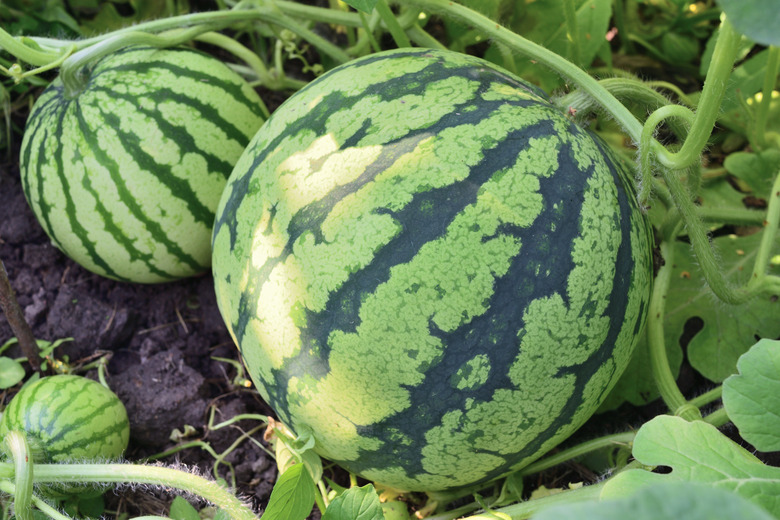When Is A Crimson Sweet Watermelon Ripe?
Nothing screams summer like the juicy, sweet taste of watermelon (Citrullus lanatus), especially when you grow it fresh in your garden. The Crimson Sweet variety produces rounded, but slightly oval, melons with a striped green skin and seeded, sweet red flesh. A Crimson Sweet watermelon is ripe in about 85 days or when the fruit looks dull. Letting your watermelon vines bask in all-day sunshine in evenly moist, gritty to sandy soil enriched with organic matter helps your watermelon grow well and ripen on time.
Crimson Sweet Watermelon Maturation Rate
Crimson Sweet watermelon plants need approximately 85 days of warm growing conditions to be productive in your garden. It takes that many days for sown seeds to sprout, develop leafy vines, bloom, and produce fully ripe melons ready for harvest. If the weather is cloudy or rainy and cool, more than 85 days may be needed. Temperatures in the range of 80 to 90 degrees Fahrenheit in the daytime and nighttime lows in the 65- to 70-degree range promote timely plant development. If you let them grow too long, the watermelons can become soft and overly ripe.
Thumping to Test Ripeness
The garden axiom of thumping a watermelon to determine ripeness has been passed down from generation to generation. Unfortunately for Crimson Sweet watermelon growers, thumping is an unreliable indicator of when to harvest and provides inconsistent insight. Presumably, a dull and low-sounding thud means the melon is ripe, but a higher-pitched, metallic sound means to leave the melon on the vine. Once they're picked from the vine, watermelons don't further sweeten or improve their flesh texture.
Monitor the Watermelon Stem
A more reliable way to determine when to harvest a ripe Crimson Sweet watermelon is to look at the color and form of the stem. When the stem connecting the melon to the vine is green and plump, the plant is still moving water and sugars into the fruit flesh and developing the seeds. Once the stem begins to naturally shrivel and turn beige to brown, the melon's seeds are mature and the flesh surrounding them is fully colored and sweet. The curly tendrils on the vine closest to the melon also shrivel and turn brown.
Melon Skin Indicators
Once a Crimson Sweet watermelon is picked and taken to market, you don't have the luxury of knowing when the melon was harvested. When choosing a watermelon at the store, examine the melon's skin to discover additional indicators of ripeness. The rind should be firm and not give when pressed with your thumb. The light and dark green-striped skin should look dull, not glossy.
Turn the Crimson Sweet watermelon over. The bald spot on the melon's bottom becomes pale yellow when it's ripe. If the bald spot is still pure white or light green, choose another melon.
